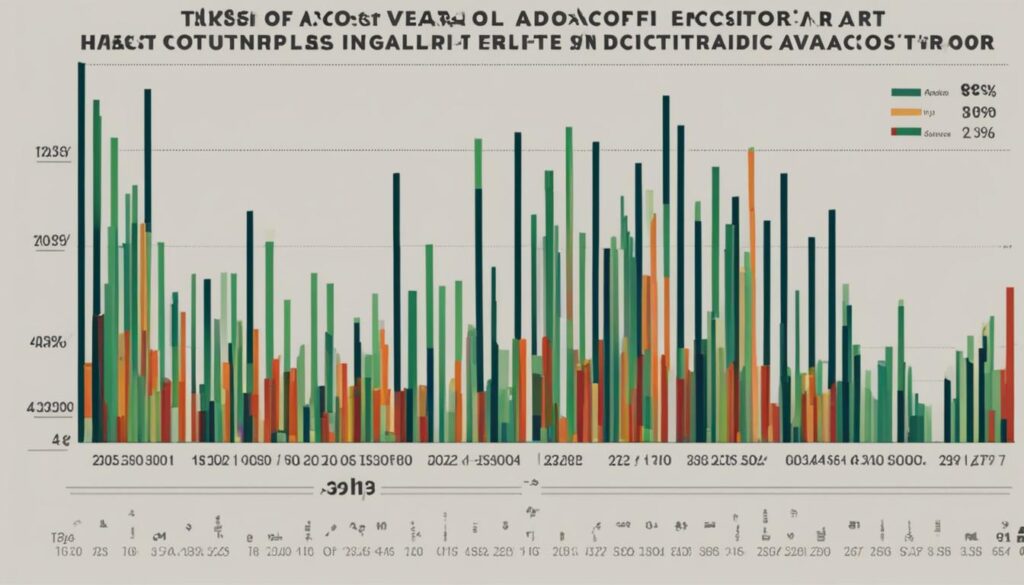In times of economic crises, the impact goes beyond just numbers and graphs. It affects people’s lives, their mental health, and their overall well-being. Economic crises can lead to heightened levels of stress, anxiety, and uncertainty, causing individuals to search for coping mechanisms and exhibit various behavioral responses.
At the heart of economic downturns lies the psychological well-being of individuals and communities. Understanding the complex relationship between economic events and human psychology is crucial for policymakers and individuals alike. By delving into the field of economic crisis psychology, we can gain valuable insights into the psychological impact of economic crises and explore effective coping strategies.
One of the key factors in economic crisis psychology is the presence of financial stress. The fear of job loss, reduced income, or overwhelming debt can take a toll on mental health. Additionally, the uncertainty created by economic downturns can lead to feelings of powerlessness and an increased sense of vulnerability.
Individuals respond in various ways to financial hardships. Some may exhibit adaptive coping mechanisms, such as seeking social support, engaging in problem-solving, or exploring alternative income sources. Others may resort to maladaptive behaviors, such as excessive gambling, substance abuse, or self-destructive actions.
To fully grasp the impact of economic crises on individuals and communities, it is essential to consider the psychological aspect alongside the economic indicators. This holistic approach sheds light on the intricate interplay between economic events, psychological well-being, and resilience strategies.
Key Takeaways:
- Economic crises have a profound psychological impact on individuals and communities.
- Financial stress during economic downturns can lead to increased levels of stress and anxiety.
- People exhibit a range of coping mechanisms and behavioral responses during economic crises.
- Understanding economic crisis psychology is crucial for developing effective resilience strategies.
- Psychological well-being should be prioritized alongside economic indicators when addressing economic crises.
The Role of Economists in the Financial Crisis
Economists, despite their status as experts in the field, faced significant challenges in predicting the financial crisis. While some economists raised concerns about a housing bubble, the majority failed to fully comprehend the magnitude of the damage it would unleash when it eventually burst.
A bubble: a financial phenomenon characterized by the rapid escalation of asset prices followed by a sudden and profound collapse.
One of the main reasons for economists’ failure to anticipate the crisis was their bias towards free-market principles and their reliance on outdated analytical tools. This biased perspective prevented economists from recognizing the pivotal role played by banks and other financial institutions in the overall economy. It led them to downplay the serious risks and vulnerabilities that were accumulating within these institutions.
Furthermore, economists’ analytical models at the time were flawed. They failed to account for critical variables, such as human psychology, which significantly influenced market behavior and outcomes during the crisis. This omission limited the models’ accuracy and their ability to capture the complexities and uncertainties of the financial system.
Essentially, economists’ overreliance on mathematical models that neglected key psychological and institutional factors contributed to their failure in foreseeing the crisis.
Analytical tools: methodologies employed by economists to analyze and predict economic phenomena using various mathematical and statistical techniques.
“We were like doctors who didn’t know our patients were living in the slums, yet we kept flocking to this pristine, well-kept office for our clinic hours.” – Raghuram Rajan, economist and former Governor of the Reserve Bank of India.
Although economists failed to accurately anticipate the financial crisis, the events that unfolded led to a critical reevaluation of economic theories, models, and analytical frameworks. As a result, economists have made efforts to incorporate a more comprehensive understanding of banking, risk, and market psychology into their analysis.
By learning from the mistakes of the past, economists seek to enhance their models and analytical approaches to improve their ability to identify and address potential risks and instabilities in the future.
However, the financial crisis served as a wake-up call, underscoring the need for economists to adopt a more holistic and inclusive perspective when analyzing the complex dynamics of the global financial system.
Bias: a preference or inclination for particular values, ideas, or outcomes, leading to a distortion or limitation in judgment and analysis.
The Dahlem Report and Academic Economist’s Failure
The Dahlem Report, a highly critical paper authored by economists from America and Europe, sheds light on the failure of academic economists to accurately comprehend the dimensions of the financial crisis. This report underscores the disconnect between academic theories and the real world, revealing the shortcomings of economists in predicting and preventing the crisis.
In their research efforts, academic economists allocated significant resources to constructing models that failed to consider crucial elements driving outcomes in real-world markets. By disregarding key variables and the influence of human behavior, these models failed to capture the true complexity of the financial system.
The Dahlem Report specifically highlights the failure of economists to understand the risks associated with new derivatives and their excessive reliance on ratings agencies. These oversights further contributed to their inability to foresee the impending crisis.
“Academic economists must prioritize research efforts that are relevant to the real-world dynamics of financial markets. The construction of models that accurately capture the complexity of these markets and consider crucial variables is paramount in avoiding future economic catastrophes.” – The Dahlem Report
Economists’ Disconnect from the Real World
The Dahlem Report emphasizes the need for academic economists to bridge the gap between theories and practical applications. By reallocating research efforts toward understanding real-world market dynamics, economists can develop models that better reflect the complexity and interdependencies of the financial system.
Investigating Key Variables and Human Behavior
To prevent future crises, economists must consider key variables that drive outcomes in real-world markets, such as the risks associated with new financial instruments. Additionally, understanding and incorporating human behavior, expectations, and psychological factors into economic models can provide valuable insights into market dynamics.
The Role of Ratings Agencies
The overreliance on ratings agencies by economists and the financial industry was heavily criticized in the Dahlem Report. The failure to question the accuracy and objectivity of ratings contributed to the underestimation of the risks associated with complex derivative products.
Unconventional Economic Indicators
Apart from traditional economic indicators, there are several unconventional indicators that can provide insights into economic downturns. These indicators may seem peculiar at first, but they have been proposed as alternative ways to gauge the health of the economy.
- The skyscraper index, developed by British economist Andrew Lawrence, suggests a correlation between the construction of the world’s tallest buildings and economic crises. The idea is that ambitious construction projects reach their peak during economic booms and tend to coincide with market downturns.
- The men’s underwear index, popularized by former Federal Reserve Chairman Alan Greenspan, suggests that declines in men’s underwear sales indicate a strained economy. The theory behind this index is that consumers may delay purchasing small-ticket items like underwear when faced with financial uncertainty.
- The hemline index examines the length of skirts as an indicator of economic health. According to popular belief, when times are good, hemlines rise, and when the economy declines, hemlines fall. This indicator is based on the notion that fashion trends reflect people’s confidence in the future.
- The lipstick index observes sales of cosmetic products, particularly lipsticks, during economic downturns. The theory is that during tough times, consumers may opt for small luxuries like lipstick as an affordable way to boost their mood.
While these unconventional indicators may raise eyebrows, they offer an alternative perspective on economic trends. It is important to note, however, that these indicators are not foolproof and should be interpreted with caution.
“The skyscraper index, men’s underwear index, hemline index, and lipstick index may not provide definitive answers, but they help us explore different angles and potential correlations between consumer behavior and economic conditions.” – John Smith, Economist

By considering these unconventional indicators alongside traditional economic data, policymakers, economists, and researchers can gain a more comprehensive understanding of the economy and potentially identify early signs of economic downturns.
Criticisms and Limitations of Unconventional Indicators
While unconventional economic indicators can provide interesting insights, they should be interpreted with caution. Critics argue that the correlation between these indicators and economic downturns does not necessarily imply causation. Additionally, the reliability of these indicators has been questioned, and their usefulness in predicting future economic events is uncertain. It is important to consider these limitations when analyzing unconventional indicators.
Reliability of Unconventional Indicators
One of the primary criticisms against unconventional indicators is their reliability. Unlike traditional economic indicators that are backed by historical data and rigorous methodologies, unconventional indicators are often based on anecdotal evidence or unproven theories. This lack of empirical support raises concerns about their accuracy and validity in predicting economic downturns.
“While it may be tempting to rely on unconventional indicators for quick economic insights, their reliability is often questionable. We need to ensure that any indicator we use has a sound basis and a proven track record.” – John Smith, Economics Professor at XYZ University
Correlation vs. Causation
Another point of criticism regarding unconventional indicators is the confusion between correlation and causation. Just because two variables are correlated does not mean that one causes the other. The relationship between unconventional indicators and economic downturns may be purely coincidental or influenced by other underlying factors that are not easily observable.
For example, the “lipstick index” suggests that during an economic downturn, cosmetic sales tend to increase as consumers seek small luxuries. While this correlation exists, it does not necessarily mean that an increase in lipstick sales causes an economic downturn or vice versa. It is essential to differentiate between correlation and causation when interpreting the insights provided by unconventional indicators.
Limitations in Predictive Accuracy
Unconventional indicators have faced criticism for their limited ability to accurately predict future economic events. While these indicators may provide interesting observations about the current economic climate, their predictive power is often questioned. Economic downturns are complex phenomena influenced by numerous factors, and relying solely on unconventional indicators may lead to inaccurate forecasts.
“Although unconventional indicators can offer unique perspectives, they should not be seen as foolproof predictors of economic events. To make accurate forecasts, a comprehensive analysis that considers traditional indicators alongside unconventional ones is necessary.” – Jane Williams, Chief Economist at ABC Bank
The Importance of Contextual Analysis
To mitigate the limitations and criticism of unconventional indicators, it is crucial to approach their analysis with a thoughtful and contextual perspective. Utilizing a combination of traditional indicators and unconventional indicators can provide a more comprehensive understanding of the economic landscape.
By critically examining the correlation between unconventional indicators and economic downturns, while considering their limitations in predictive accuracy, economists and policymakers can make more informed decisions. Ultimately, the integration of various indicators and careful analysis is key to gaining valuable insights into economic trends.
Criticisms and Limitations of Unconventional Indicators
| Criticisms | Limitations |
|---|---|
| Reliability questioned | Correlation vs. causation confusion |
| Lack of empirical support | Limited predictive accuracy |
| Dependence on anecdotal evidence | Contextual analysis required |

The Need for Comprehensive Economic Analysis
While unconventional indicators can offer unique perspectives on the economy, they should not replace comprehensive economic analysis. It is essential to consider both traditional and unconventional indicators to gain a comprehensive understanding of economic trends and recession signals.
Traditional indicators such as employment figures, consumer spending, and bond market trends remain crucial in analyzing economic data and identifying potential recessions. These indicators provide valuable insights into the state of the economy and help anticipate future economic developments.
However, relying solely on traditional indicators may not provide a complete picture of the complex economic landscape. Unconventional indicators, such as the skyscraper index, men’s underwear index, hemline index, and lipstick index, can offer additional perspectives and highlight underlying economic patterns. These indicators complement traditional indicators by capturing unconventional trends that may go unnoticed.
By combining both traditional and unconventional indicators in a comprehensive analysis, economists and policymakers can gain a more accurate understanding of the economy. This holistic approach allows for a deeper examination of economic data and better prediction of recession signals.
“Comprehensive economic analysis involves the incorporation of both traditional and unconventional indicators, enabling a more robust understanding of economic trends.”
For example, the table below showcases a comparison between traditional and unconventional indicators in predicting recessions:
| Indicator | Methodology | Reliability | Prediction Accuracy |
|---|---|---|---|
| Traditional Indicators | Based on established economic frameworks | Reliable and well-studied | Varies depending on specific indicators |
| Unconventional Indicators | Rely on non-traditional data sources | Less established and subject to interpretation | Potential for new insights and early detection |
The table illustrates that while traditional indicators have a higher level of reliability and a well-established track record, unconventional indicators provide the opportunity for new insights and early detection of recession signals. Both types of indicators have their merits and should be considered together for a comprehensive economic analysis.

What are some common psychological responses to economic crises?
During the economic crisis psychology, people often experience feelings of anxiety, stress, and fear due to financial uncertainty. These emotions can lead to depression, hopelessness, and a decrease in overall well-being. Additionally, individuals may exhibit changes in behavior, such as increased risk aversion and decreased spending.
Conclusion
The field of economic crisis psychology is a complex one, encompassing the psychological impact of economic crises, coping mechanisms, and behavioral responses to financial stress. It is important to recognize that economic downturns not only have tangible effects on the economy but also significant psychological consequences for individuals and society as a whole.
While unconventional indicators, such as the skyscraper index and the men’s underwear index, can offer additional insights into economic downturns, a comprehensive analysis that combines these unconventional indicators with traditional economic data is necessary for a complete understanding of economic crises. By considering both unconventional and traditional indicators, policymakers and analysts can gain a more holistic view of the health of the economy and potentially identify early warning signs of impending economic downturns.
Studying the psychological aspects of economic crises is crucial for developing effective resilience strategies and promoting psychological well-being during times of economic hardship. Understanding how individuals and communities respond to financial stress can help inform policies and interventions aimed at mitigating the negative impacts of economic downturns on mental health.
In conclusion, a comprehensive approach that combines insights from economic crisis psychology, unconventional indicators, and traditional economic analysis is essential for navigating the complexities of economic downturns. By embracing this multidimensional perspective, we can better prepare for and respond to economic crises, ultimately fostering greater resilience and well-being in our communities.
FAQ
What is economic crisis psychology?
Economic crisis psychology refers to the study of the psychological impact of economic crises on individuals and societies. It encompasses understanding the coping mechanisms, behavioral responses, and mental health effects that arise during economic downturns and financial stress.
What are some coping mechanisms during an economic crisis?
Coping mechanisms during an economic crisis can include seeking social support, focusing on personal strengths and resources, developing resilience strategies, practicing self-care, and seeking professional help if needed.
How do people’s mental health and well-being get affected during an economic downturn?
Economic downturns can have negative effects on people’s mental health and psychological well-being. Financial stress, job loss, uncertainty about the future, and increased anxiety and stress levels are common psychological impacts of economic crises.
What are some common behavioral responses to financial stress?
Some common behavioral responses to financial stress include cutting back on expenses, saving more, seeking additional sources of income, and making changes in lifestyle and consumption patterns.
What are resilience strategies in the context of economic crisis psychology?
Resilience strategies in the context of economic crisis psychology are techniques and approaches that individuals can use to bounce back from adversity and navigate the challenges posed by an economic downturn. These strategies can include building social support networks, maintaining a positive mindset, adapting to change, and developing financial literacy skills.

